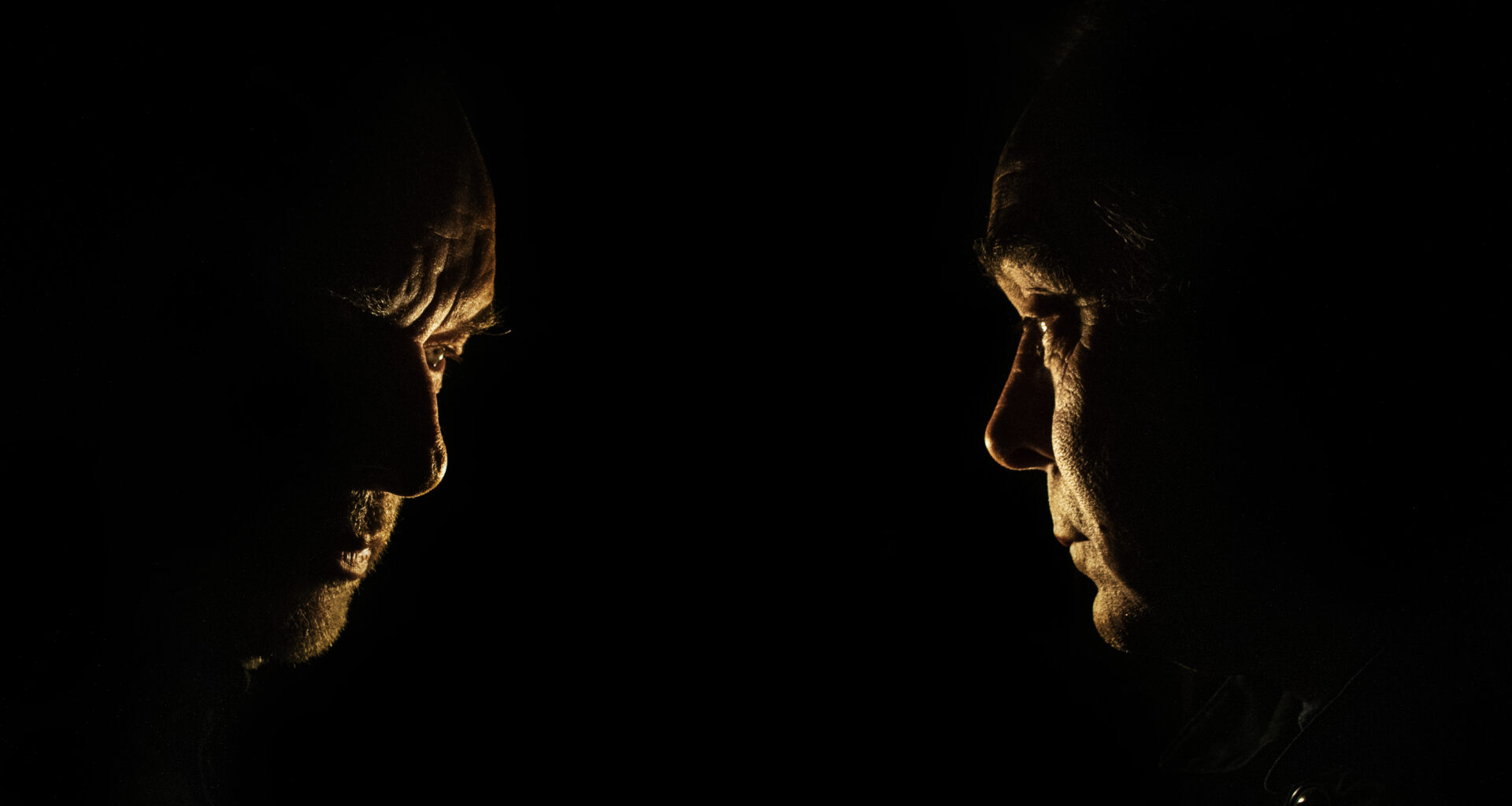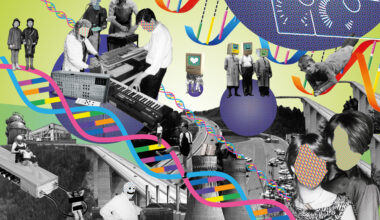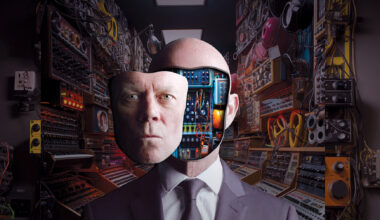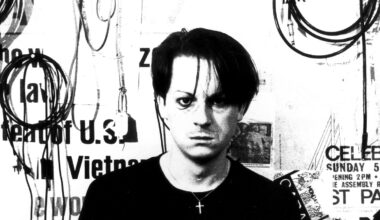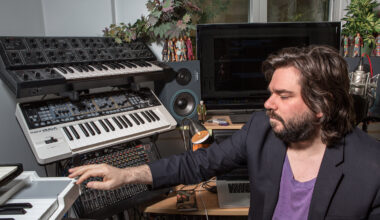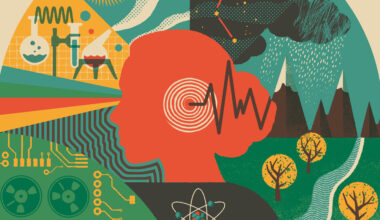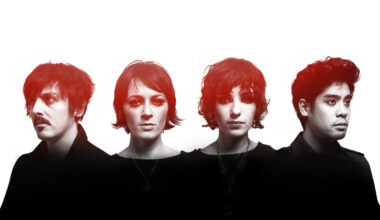As you might expect from an afternoon with Roger Eno and Brian Eno, whose ’Mixing Colours’ album sees them working together as a duo for the first time, there’s plenty of talk of algorithms and double pendulums and sound worlds. And jokes.
Brian Eno’s west London studio is discreetly tucked away in the corner of a mews cul-de-sac, which is only revealed when you venture up a road flanked by walls and so narrow that you wonder if you could actually get any mode of transport larger than a horse along it. The whole place is sort of there and not there.
This magic trick of urban cloaking repeats itself when you walk into Eno’s seemingly slender building. It opens up, TARDIS-like, into a large, very high-ceilinged, white-painted space. It’s part-recording studio, part-private art gallery, part-library. This is Brian Eno’s London lair. A good place to get some thinking done, as David Byrne once put it. Whether it’s Eno’s music, his artworks, or any of the many other activities that occupy his time, there’s room for it all here. A few of his light installations adorn one wall. There’s a new, smaller iteration being tested on another wall, around the size of an LP, a frosted white Perspex box featuring a doorway shape and a constantly shifting array of colours.
I’m here to talk to Brian and his brother Roger about their new album, ‘Mixing Colours’. There’s no sign of the Eno brothers, but I can hear them. In the recording studio off to one side, a piano is being played. Brian Eno is raving about the sounds. Roger Eno might be playing the keyboard, but I can’t see. After a couple of minutes, they emerge, full of friendly greetings and apologies, and enthusing about the piano software they’ve just been mucking about with – Pianoteq by the French company Modartt.
“God, it’s exciting!” says Brian, as he and Roger join me at a table in the middle of the larger space. “It’s based on physical modelling, where you set up equations for how the strings resonate and what noises you get when a hammer hits a string. If you want to find out what a piano might sound like if it was 130 feet long, you can do that. In fact,” he adds, addressing Roger, “what you were enjoying there, when you mentioned all those high harmonics, you get those when you make the strings very, very short.”
Brian thinks the software might enable Roger to perform ‘Mixing Colours’ live, by reproducing some of the manipulations he applied to Roger’s piano playing on the album in real time.
“This is the first time I’ve looked at it,” says Roger. “I like pianos that are old and busted up, and you’ve got that there.”
“They’ve been working on this for a while…” begins Brian.
“They’re known to be a very lazy company,” jokes Roger.
“Well, they’re French,” says Brian.
“Long lunches…”
“That’s why we left the EU, isn’t it?” fires back Brian. “If we’d have thought it up, we’d have got it done in a few months. They’ve been working on it for years.”
And therein lies a snapshot of the relationship between the Eno brothers – from discussing the harmonic properties and algorithmic smarts of a new piece of software to taking the piss in under 10 seconds.
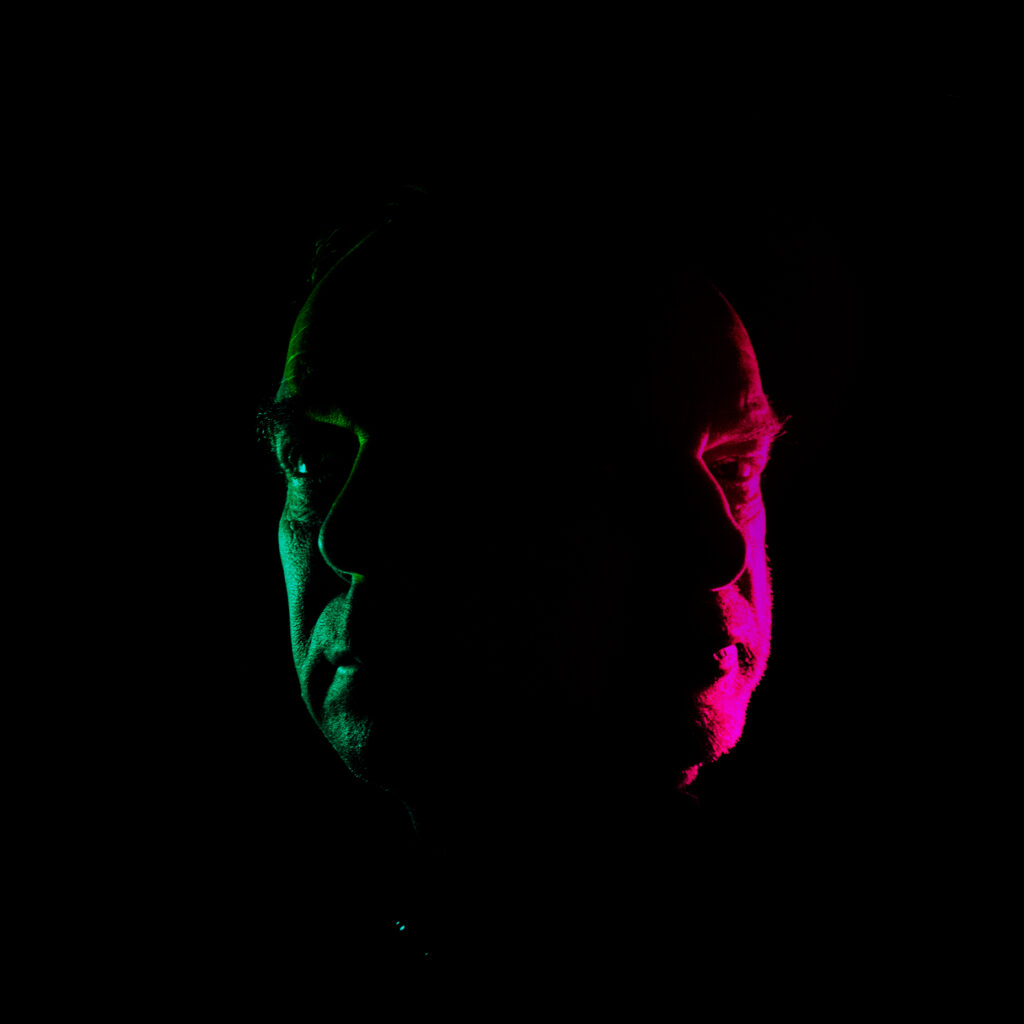
‘Mixing Colours’ consists of 18 beautifully subtle piano pieces originally created by Roger and placed in a new sound world by Brian. It’s on the venerable Deutsche Grammophon label and is the first record the brothers have released as a duo. There was ‘Apollo: Atmospheres And Soundtracks’ in 1983, which was written, performed and produced by the two Enos and Daniel Lanois, but I wonder why they haven’t released an album together like this before.
“Well, straight after ‘Apollo’, Brian produced my first solo album,” says Roger.
“Oh yes, that’s right,” remembers Brian. “That was 1984 or 1985.”
“We did a couple of films, ‘Dune’ and something else…’ adds Roger. “‘Opera’, the Dario Argento film…”
“But this is the first product, if you like,” says Brian.
Was there a feeling that you didn’t want to work together too obviously?
“I never thought of it actually,” says Roger. “It never crossed my mind.”
“Nor mine, really,” says Brian. “We were working together, in the sense of exchanging these pieces of music, but that was kind of for fun. Then the fun turned into an album. It’s been downhill all the way, really.”
“This album was sort of by accident,” notes Roger. “We’ve both been doing different things.”
“And we didn’t live close for most of that time, actually,” says Brian. “Now I have a place in Norfolk, which is not far from Roger.”
“I made the mistake of writing him letters, telling him how great that part of the world was,” says Roger. “So the bugger moved there. It was going great until then. Curse my literary ability!”
“Now the whole place is being gentrified, because they’ve all followed me there,” deadpans Brian.
‘Apollo: Atmospheres And Soundtracks’, splendidly reissued last year, was the soundtrack album for Al Reinert’s documentary movie ‘Apollo’, which was later re-titled ‘For All Mankind’. Film and television music has always played a large part in both brothers’ musical output, and it was film that prompted the creation of ‘Mixing Colours’ too.
“I’ve got a huge amount of Roger-based pieces, and about a year-and-a-half ago I thought it would be quite good if I could put together a selection of them that Rog could send out to film directors, because it seemed to me to be very cinematic music,” explains Brian. “Whenever I played any of those pieces I’d think, ‘This is so nice, and it’s all just sitting there’. So that was the first thought, to put together a collection to go out to film directors and programme makers. Having done that, I listened through, and so did our manager Ray, and we both said, ‘This is a good album…’. So ‘Mixing Colours’ was sort of made by default.”
“It’s a great way to do something,” says Roger. “Because by the time you’ve realised you should do something, you’ve done it!”
Roger is the kind of person who likes to keep life simple. He plays piano every day and, it seems, the stresses of an international recording career don’t impinge greatly.
“I’ve got such an easy life,” he says. “Deliberately so. It’s bicycles and beach walks for me. I’d rather have time than money.”
There’s a pastoral pace about both Roger and his music, which is always gentle, melodic and spacious. He has a bemused and amused slant on proceedings. He’s a piano player who likes to play piano, but without concerning himself with the worldly details of schedules and career organisation. You can imagine that he’s at his happiest enjoying a quiet pint in a country pub.
Brian, on the other hand, is a more urban and urbane presence, though his East Anglian accent is still intact. He thrives on the fizzing energy of cities and no doubt has people constantly on his case saying, “Where’s our next record?”.
“Nobody ever says that to me,” notes Brian.
“No!” laughs Roger. “They dread it!”
“I say, ‘Sorry, it’s not ready yet’, and they say, ‘Thank God for that!’.”
“‘The last one was a mess’, you hear them mutter as they walk off.”
“‘Take as long as you like…’”
“‘God, it’s those two… Jesus…’”
“‘Don’t call us…’”
“‘Just don’t…’”
Joking apart – and there is a lot of joking – ‘Mixing Colours’ was received with open arms by Deutsche Grammophon, where Christian Badzura has been shaping the label’s contemporary composer list with the likes of Max Richter, Hildur Guðnadóttir, and the sorely missed Jóhann Jóhannsson. The album emerged by a sort of gradual osmosis between the two brothers and the label. Roger has been sending pieces of music to Brian for years.
“Just because he’s my brother and I thought he’d be interested to hear what I was up to. He liked some of them and kept them, and he logs everything, whereas I just lose things, so this is quite handy.”
“You probably wouldn’t have remembered a lot of the pieces on the album,” says Brian.
“Definitely,” nods Roger. “I recorded all of them in the morning. I’d get up, go straight to the studio, improvise, and see what came out. I don’t exercise, you see, so you have to do something when you get up. It’s when you’re not critical, not in editing mode, you just do this and send it. Some are good, some are bad.”
Were you sending them as MIDI files or as audio?
“When Brian realised there could be something useful in this, he said to send the MIDI file as well. I don’t know if you’ve got them all, there might be some early ones…”
“I’ve got a lot,” affirms Brian.
When did you think about doing something with the pieces, Brian?
“Oh, I wasn’t thinking about making an album until last year. No, it was just fascinating for me to have MIDI files of music that I liked, that I could play with. I’m always fiddling around with ways of using software and so on, but that’s usually associated with the idea of composing something. So I had this luxurious situation where the composing was done, or well on the way anyway, and I could just focus on this thing I like doing, which is thinking, ‘What’s the sound world that I could invent for this?’.
“I was doing nearly all of it on trains. They were nearly all made travelling. I travel by train a lot. I take my computer – there it is [he indicates a battered-looking MacBook] – and for me it’s a pleasure, sitting on a train with the landscape going by, and sort of building a piece of music that somehow seems to relate to that.”
Brian manipulated the data on Roger’s MIDI files in various ways, using it to create a wider electronic soundscape that surrounds Roger’s melodies. Sometimes he would tip the MIDI file’s note content upside down.
“A MIDI file is only data,” he explains. “It’s just information about when fingers hit keys, how hard they hit them, and how long they stayed there. It’s a very small amount of information, so you can do things with it. You can turn it over, reverse it, invert it, and they all change values when the ones that aren’t octaves invert, so you get strange pieces.”
Brian shows me the folder of Roger’s compositions he’s manipulated on his computer. There are nearly 150 of them. He has added notes in the file view: “Slightly unexpected”, “Horrible sound”, “Unbearable”…
The ones that work, then, do you see them as hiding in the original melody?
“Yes,” he replies. “I just keep going until I find something that is interesting. In fact, the beautiful pieces are the easiest ones in a way, because I’m just decorating them. But what’s interesting is occasionally getting a MIDI file and thinking, ‘I can’t think of anything to do with that’. But that’s good. That’s when there’s a challenge.”

Over the course of the afternoon, it becomes clear that neither brother is au fait with the track titles on their album. They know the 18 pieces well, they just don’t know what they ended up being called. We listen to the album via Brian’s laptop on some Bose speakers, which Brian is very enthusiastic about.
So where did the colour theme of the record come from?
“One of the pieces Roger sent me was called ‘Mixing Colours’,” says Brian. “I’m not sure that track ended up on the album, actually…”
“Search me,” says Roger, shrugging his shoulders.
“I thought that was quite a nice title and then I had this idea of using colour names for all the tracks,” continues Brian. “Originally, I started out making a cover made up of stripes of colour, so each stripe had a title on it which was the name of the colour, but it was pretty ugly really. Then Roger had the very smart idea of using a painting by a friend of ours that he got me for my birthday last year. So with that as the cover picture, suddenly it made much more sense, especially given the Deutsche Grammophon connection. It does look really good. [To Roger] Except, you know they’re not using Deutsche Grammophon yellow?”
“Oh, that’s a pity,” says Roger, although he doesn’t appear too distraught.
“It’s white. But it makes the design look better, I think.”
We start talking about the fanciful names that paint colours go by. I had promised myself that I wouldn’t mention the paint aisle at B&Q, but before I know it I’m telling the Eno brothers that I’m decorating my house and I’ve had difficulties choosing a colour.
“We’re the guys to ask,” says Brian.
“None better,” affirms Roger. “In fact, we can do it for you.”
I tell them I chose Wispy White.
“Lovely,” smiles Brian, seemingly sincere.
“I asked directions earlier in the Farrow & Ball shop around the corner,” says Roger.
“Did you?” asks Brian. “What did they say?”
“’Take the Elephant’s Breath…’”
“‘There’s a Cook’s Blue building, then there’s a Fresh Salmon building, go past those two…’”
“But back to what you mentioned before,” says Roger, extricating himself from the latest Eno brothers gag fest. “A lot of people don’t work like this. We’re in the unusual position of being…”
“Short?” offers Brian.
“Yes. Very short. And almost ineffably handsome.”
“The paradox is what gets people,” shoots back Brian.
“It keeps women talking for weeks while they’re being waxed.”
“It’s the sort of Marmite of manhood.”
“Masculine Marmite, that’s another colour! And the awful thing is, it’s white!”
Somehow, thanks to the painting Roger gave Brian for his birthday, the idea that colour should provide the album’s nomenclature formed. Desutsche Grammophon did the rest.
“They were very important in helping this project take shape,” notes Brian. “Ray sent them a lot of pieces, I think there were 51 tracks, and Christian at the label got very excited about them. So I said, ‘Why don’t you make a selection of the ones you like best and make a running order as well!’. I find those very difficult. I know the pieces so well, because I’ve spent a long time over the years listening to them, and that’s not a very good position for making a running order. It’s almost better if someone from the outside can do it. Anyway, Christian took the challenge and did a fantastic job. That running order, I think, is exactly what he suggested with just one addition, the last track, which was added on later.”
Is colour in music something you think of consciously when you’re playing, Roger?
“I wouldn’t say it’s a primary, it’s not my diving board. But muted is. It’s not about colour, it’s about hue.”
“Or intensity and complexity,” says Brian. “If you think about colours, there are primaries and then there are secondaries and tertiaries, and I think you’re generally in the secondary and tertiary zones, rather than the primaries.”
“There you go, certainly,” says Roger. “That’s where I’d go, so I don’t think about it. You’re then in moods and I think about what mood I want to create a huge amount. Whereas if you’re in the realm of colour, it’s almost about what sort of picture you want to paint. It gets much more graphic. I know these analogies are crossing over, but you get the idea.”
“If you talk to people who have a classical background and don’t know about anything else, they assume that the ingredients of music are things like melody, tempo, rhythm, blah-blah-blah,” muses Brian. “They very rarely mention timbre or colour as an important ingredient, it’s a sort of secondary consideration. And that’s partly because, classically, there weren’t that many colours to play with. You had the clarinet, which, in the cast of a multi-dimensional universe of colours, is a little planet, and somebody might stretch that a bit by being able to do something you couldn’t do before on the clarinet. Then you had the violin, the viola, and so on. They’re all tiny pockets of sounds that we’ve managed to create.
“What happened with electronics was, you could expand those hugely, but you could also explore places that had never even had a name before. So a lot of what we’re doing, what I’m doing at least, is to think, ‘Ooh, that’s a space I’ve never been in before and nobody has ever heard before’. Imagine if somebody in the 1930s had said to painters, ‘I’ve found a way to make colours you’ve never seen before’, and your little Winsor & Newton paint box suddenly became as big as this room, with all these tablets that were new sensations…”
“Neon…” offers Roger.
“Neon, yes, but not just variations of existing colours, these are new experiences. Well, that’s sort of what happened in popular music. I think classical music has completely not understood that and has not explored it very much. For pop music, it’s been one of the main subjects. If you think, what is the difference between this song written on I, IV, V chords, and the 77 million other songs written on I, IV, V chords, it’s nearly always timbre. The voice is [does a thin nasal grunt and then a more chesty one] or whatever, and then there’s a guitar sound that’s exciting and which you’ve never heard before. So timbre is the sort of building block of pop music, but the skills the people have acquired in that, me included, have rarely been applied to this kind of music. So this is interesting, I think.”
“In the classical world, the modernist world, you get tragedies like Stockhausen and Ligeti trying to do something ‘other’ and it all sounds uniformly horrible,” says Roger. “Whereas most things in the pop world sound good, to varying degrees. If you listen to a piece of 1950s modernism working in the world of timbre, trying to get somewhere in that, it just sounds awful. People are trying to get something, but they’re getting… well, shit, frankly.”
Roger’s commitment to lyrical and melodic music certainly puts him at odds with the angular clashings of modernism, though given that Stockhausen and Ligeti were both Deutsche Grammophon composers, it might be politic not to trash their output too much.

If you’re not familiar with Roger Eno’s back catalogue, the 2013 compilation ‘Little Things Left Behind’ on All Saints, a collection of his music from 1988 to 1998, is a good place to start. There’s also his more recent albums of piano and electronics with Plumbline (‘Endless City / Concrete Garden’ and ‘Transparencies’) and his own ‘Dust Of Stars’ from 2018. ‘Mixing Colours’ is very much part of that continuum.
So is there likely to be another Eno/Eno album?
“I’ve got plenty more stuff,” answers Brian. “I think there’s enough for another really good album there.”
We spend the rest of the afternoon looking at slow motion videos of a Japanese Daruma doll rocking back and forth on Brian’s phone (slow motion iPhone videos are one of the many things lighting up Brian Eno’s world at the moment) and enjoying an extended discussion on the physics of double pendulums, with which Brian is somewhat obsessed. He used to have an enormous one in the studio, but its flailing metal weights were so dangerous he had to have it removed. Instead, he’s had 20 small ones made. He and Roger engage in a good-humoured argument about the behaviour of the double pendulums until Roger concedes defeat. They then ponder whether they should pop to the nearby cinema to catch ‘Parasite’.
“It would be as easy as falling off a log, as David Byrne used to say,” says Brian. “And probably still does.”
“He still falls off logs?” asks Roger.
“All the time. That’s why he’s so disorientated.”
And with that final snapshot of life with the Enos, we head off into the night.
‘Mixing Colours’ is on Deutsche Grammophon
